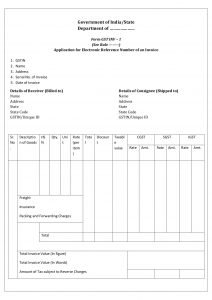GST Invoice : Points to be kept in Mind.
- Posted on Jul 29, 2017
- |
- By Dhruv
Invoice and GST :
Invoicing is one of the most important function when it comes to the purpose of execution of any financial transaction. Now, with the advent of GST; old methods of preparing an invoice has become obsolete and thus an entirely new format has to be followed for creating an invoice.
Basically GST is not as tricky as it seems and a novice in accounting can also understand it and for that Government has given a proforma for the GST invoice, which gives us an idea regarding the changes to be made in our existing invoice.

Proforma
The above Image shows a standard invoice and field which should be included in your invoice. There are no specific format to follow for generating an invoice but government has made it compulsory to include some fields like GSTIN, etc.
Particulars which should be included in the Invoice:
- Name, Address & GSTIN of supplier
- Consecutive Serial Number
- Date of issue
- Name, Address & GSTIN (if registered) of recipient
- HSN/SAC code (as per eligibility on turnover basis)
- Description of Goods, Quantity & Taxable Value
- Rate & Amount of Tax – CGST, SGST, IGST
- Place of Supply
- Reverse Charge
- Signature or Digital Signature
Points to remember:
The Central Board of Excise and Customs and Commercial Department has released information about invoices under the GST to simplify the knowledge of common man and to make them aware of changes they have to inculcate while preparing an invoice.
Following are the points which were published by them:
- There is no such specific format to be followed while preparing an invoice.
- GST law requires only certain fields that must be in an invoice. For example, GST number of recipient, name and address,etc.
- Under GST there is a specific time period mentioned for issuing invoice and it is different for goods and services. For goods, an invoice has to be issued before the delivery of goods, i.e. before the goods is dispatched from the seller’s warehouse or store. For Services, the invoice can be generated within 30 days from the date of supply of service.
- Small taxpayers, like small retail houses, dealing up with small transactions upto a value of Rs. 200 per transaction to the customer who are unregistered need no issuance of invoice for every such transaction they can prepare a consolidated invoice at the end of each day for all the transactions which were carried out during the day. Although if the customer demands for an invoice then they should issue them invoice.
- Earlier transporter were required to carry one copy of invoice along with them. Now, GSTN provides a facility to obtain an invoice reference number and if a taxpayer has generated this number, then his goods don’t require a physical invoice during transportation. This will help to solve the problems like paper invoices getting misplaced, destroyed, ripped or lost during transportation of goods.
- In order to keep the compliance burden low on taxpayers, GST has a provision for taxpayers whose annual turnover is up to Rs. 1.5 crore and thereby they don’t have to mention HSN code of the goods in the invoices.
- If the quantity of the goods to be transported is unknown at the time of removal of goods from the warehouse, at that time goods can be removed on the basis of delivery challan and invoice may be issued after the delivery.
There are two kinds of Invoices under GST:
-
Tax Invoice
-
Bill of Supply
1. Tax Invoice:
A tax invoice is an invoice issued by a registered dealer to the purchaser, showing the amount of tax payable.
2. Bill of Supply:
Whenever a registered supplier conducts a supply of goods or services which are exempted or at times the receiver of the goods or services is not registered or where the supplier is not allowed to charge tax of any kind from the recipient , at that time Bill of Supply is issued.
The instances where a registered supplier needs to issue the bill of supply:
- Supply of Exempted , Non-taxable/Non-GST goods or services
- Paying tax under the composition scheme
Though GST has created confusion in the minds of taxpayers, but it isn’t as difficult to grasp as it is presumed by taxpayers. With proper accounting assistance and by getting in touch with news on GST and press releases made by government on GST we all can burst the GST Bubble which is prevailing in the minds of taxpayers.
To come out from all this hassle regarding GST and GST Invoicing, a proper accounting software is the solution as it is already integrated with GST rates and rules/regulation to be followed therein.
A layman who has a little knowledge about accounting can also file for tax easily with the help of an accounting software.
Zybra is a Cloud Based Accounting Software which is GST ready and can solve all your accounting problems.
- Posted on Jul 29, 2017
- |
- By Dhruv
- |
- 0 Comments

Leave a Reply